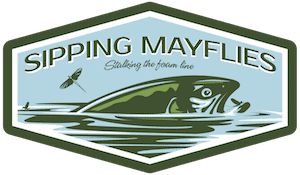Fly Fishing For Whitefish
October 6th, 2023
I’ve had a lot of success fly fishing for whitefish. In fact, I really enjoy sight-fishing for them. My goal with this article is to teach you how to catch whitefish on a fly more effectively and deliberately.
Whitefish are, in my opinion, vastly underappreciated as a gamefish by most fly anglers. The same anglers who look down upon anything other than trout. This is a mistake.
But, between you and me–I relish their disdain for all non-trout species. I wouldn’t change a thing. I revel in it.
Whitefish fish put up a good fight, live in beautiful places, and are very willing to take a fly.
There are several species of whitefish in North America, but we’ll be focusing on the most prolific of them, the Mountain whitefish (Prosopium williamsoni). Regardless, the techniques we’ll cover will work successfully on all the whitefish species.

Here’s a nice mountain whitefish I caught in January on a size 20 dry fly. Catching whitefish on dry flies is a low probability method. Nymphs are far more effective.
Whitefish Species
While we’ll focus on the mountain whitefish (Prosopium williamsoni), as I mentioned, here’s a list of a few other whitefish species found in North America:
Lake whitefish (Coregonus clupeaformis)
Round whitefish (Prosopium cylindraceum)
Pygmy whitefish (Coregonus coulteri)
Bonneville whitefish (Prosopium spilonotus)

Here’s a +/- 20-inch whitefish I caught on a January day while sight fishing on a local river.
Why Target Whitefish?
So many reasons. But I’ll take a crack at it.
Considered a nuisance by many anglers, whitefish are mistakenly considered competitors with trout. Yet, this really isn’t the case. Whitefish are toothless and feed primarily in the silty bottom of rivers and lakes, where they dig for invertebrates. They’ve been living harmoniously with trout for eons.
Whitefish fishing seasons are generally year-round, which means you can target them when other trout species may be protected (or avoided) during their spawning periods.
Whitefish are very active winter feeders too, at a time when trout slow down their feeding. This makes them very “catchable” when other species may be reluctant. They’re also less discriminating eaters.
One thing I’ve found to be an unassailable truth is that whitefish don’t spook nearly as easily as trout. Many times I’ve had them school at my feet while I cast for rising rainbows. Even if I take a few steps, they come right back. I imagine they like eating the small organisms my movements kick-up from the substrate.
They’re members of the Salmonid family. Yes, just like salmon, trout, and char.
Whitefish can put up a fight, too. They’re not as strong as rainbows, but they’re respectable. In fact, you’ll notice that many fly anglers won’t know they’ve hooked into a whitefish until its at the net.
Finally, most states have very high bag limits (here in Idaho it’s 25 whitefish per angler), and their meat is good eating if you’re handy with a filet knife. If not, watch out for bones. Smoking the meat is the best way to enjoy it. Also, for whatever reason, their meat isn’t as tasty during the summer season.
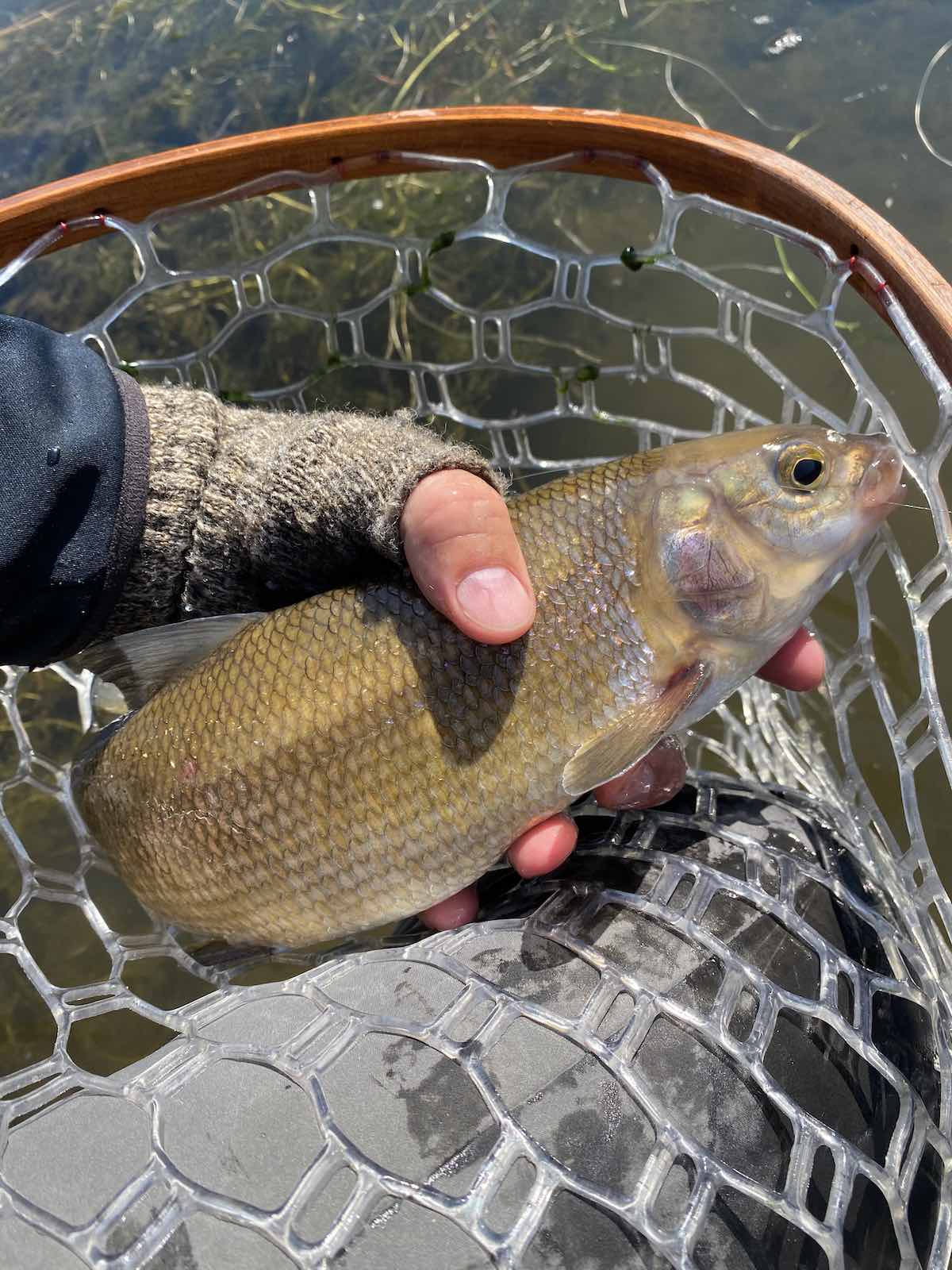
I caught this whitefish in mid-October on a nymph pattern that this species has a hard time ignoring. More on the specific pattern below.
Where to Find Whitefish
In the interest of full disclosure, I’ve never gone fly fishing to specifically target whitefish. They just happen to inhabit the same waters as many of the fish I chase, such as various species of trout, and I’ve learned to appreciate them.
If you live in the Pacific Northwest, chances are you’ve got whitefish living very close to you. Mountain whitefish, specifically, are found in Washington, Oregon, Nevada, Idaho, Montana, Utah, Wyoming, Colorado, parts of Northern California, and most of British Colombia and Alberta in Canada.
In contrast, the lake whitefish has a relatively wide distribution across the northern and eastern United States.
Use the USGS range maps below to determine if you’re in the vicinity of some “whiteys.”
Rivers, streams, and creeks will be your best bet, but they can also be found in lakes and reservoirs. In fact, the most whitefish I’ve ever seen in one spot was in a lake. Lakes fed by a body of water will be more likely to hold whiteys than a stand-alone body of water.
They much prefer cold water, and will rarely if ever be found in warmwater areas.
Once you’ve located a body of water that holds whitefish, it’s time to start scouting.
Focus your efforts on pools and deeper water. Yes, whiteys can be found in riffles, but your best bet is a deeper section of water.
Watch for schools of fish since whitefish usually school together. And, they’re almost always hugging the bottom. We’re talking 99.9% of the time.
In the correct light, their backs will have a sort of glittery appearance. I’ve heard it described as reminiscent of a disco ball.
Fortunately for you, various Fish & Wildlife departments have found rivers where whitefish outnumber trout by 5X to 10X. The odds are in your favor!
Here are a few USGS (United States Geological Survey) range maps showing the estimated distribution of various whitefish species.
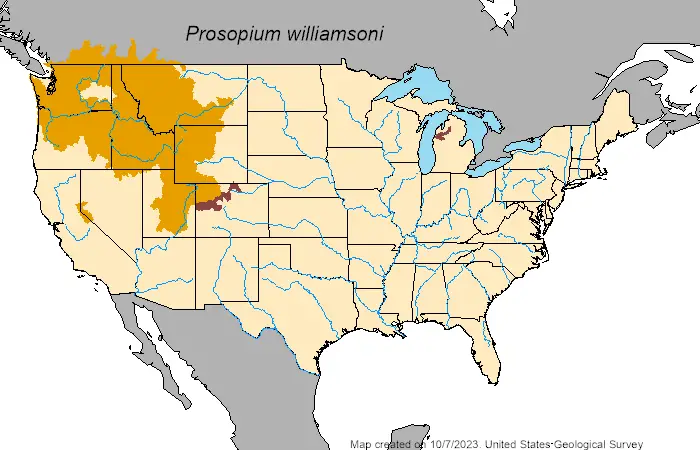
Mountain whitefish (Prosopium williamsoni)
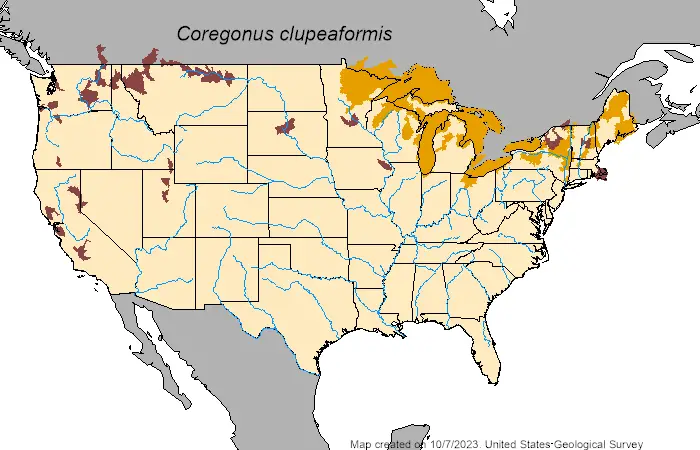
Lake whitefish (Coregonus clupeaformis)

Round whitefish (Prosopium cylindraceum)

If you’re an angler, you know that pictures rarely do a fish justice. With that said, here’s a really big mountain whitefish I saw in a lake in early October. I’ve learned that large whitefish are much more solitary. This was looked to be around 18-inches long.
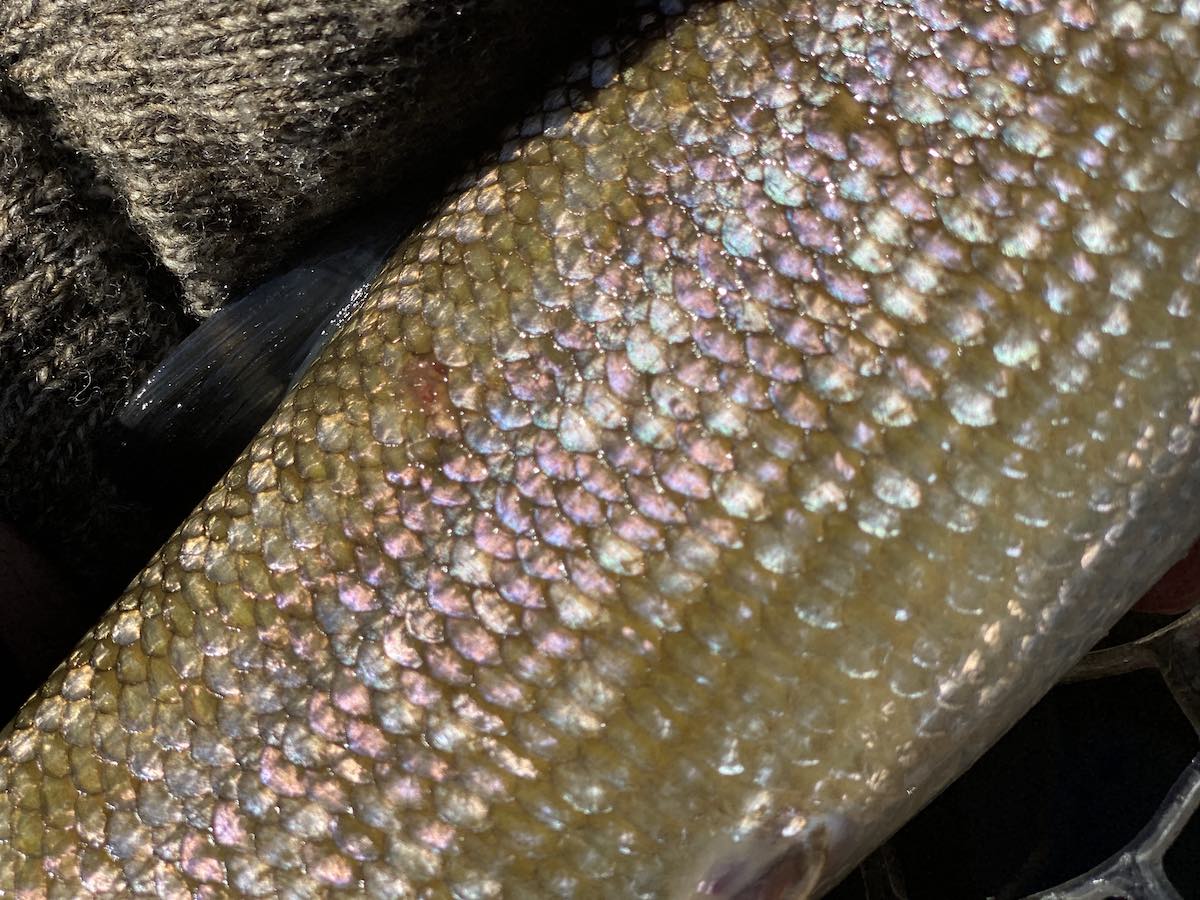
Here’s a close-up picture I took of a whitefish to show the glittery “disco ball” appearance they can have underwater.
Whitefish Fly Fishing Tactics
Once you find where the whitefish are holding, your primary goal should be getting down to them. This can be easier said than done.
Whitefish mainly focus on what’s below them. So, that’s where you want your fly. They’re called “demersal” feeders, which means they stir up the substrate with their tail and pectoral fins looking for prey.
Yes, they’ll rise to eat occasionally, but this is the exception and not the rule. More on that later.
You’re going to need some weight–preferably weighted nymphs. I’ll tell you about the absolute best fly for whitefish in the next section.
Regardless of the specific fly pattern you use, you’ll either need the nymph to be weighted (ie. beadhead), or you’re going to need to add weight to your line. I usually prefer the former (beadhead).
I usually don’t like adding split shot or tungsten putty to my line because it creates a hinge in my setup. This “hinge” means detecting a take is just a bit more difficult.
Now, you could argue that using split shot or tungsten putty means you can use unweighted nymphs, and unweighted nymphs have more movement in the water, which might seem more natural to the fish.
Experiment. That’s what I always say. Try one method, and if that doesn’t work, try another method. Experimenting and problem solving is one of the main reasons fly fishing is so fun!
Tie on a couple nymphs if regulations allow. Try one weighted and one unweighted, or two different sizes. This helps you figure out what they want on that particular day.
When you attach your tippet to your leader (usually via a double or triple surgeon’s knot), don’t nip both ends of line. Instead, leave a piece of line long enough to tie-on your leading nymph. This will make it easier for the fish to eat, rather than having the nymph in-line with the rest of your leader.
Whitefish have small mouths, so don’t use big flies. Dropping small streamers, such as a woolly bugger, in front of the fish can work, but it’s a lower probability play.
Use fluorocarbon line if your budget allows. Not only is fluoro stronger than mono, but more importantly, it sinks and is less visible than monofilament.
Below are a couple videos I took, both showing how whitefish school. The first is in a lake, and the second is in a creek.
Since they tend to be in schools, if you catch one whitefish, you can bet there are more holding in the same spot. The only exception to this rule has to do with big whitefish, which I’ve noticed tend to live solitary lives.
The Best Flies for Whitefish
Earlier I mentioned that nymphs were the most effective fly for hooking into whitefish. And, that’s certainly the truth. You can bank on it.
But I also mentioned that there was one nymph pattern that rose above the rest. It’s like whitefish candy.
That fly is the prince nymph.
The prince nymph outperforms even the pheasant tail, which is really saying something. Whitefish are just drawn to it, for whatever reason. You can get a dozen of them very inexpensively on this Amazon page.
Now, don’t misunderstand. Whitefish aren’t discriminating eaters who are hard to fool. Quite the opposite.
In the wild, their main food is caddis larvae, mayfly larvae, midge larvae, and stonefly nymphs, which they mainly dig up on the bottom. There are plenty of great representations of these bugs in the fly fishing world.
But if you really want to get the job done, the prince nymph is your highest probability play. Use it in sizes 14 to 22.
Streamers for whitefish
While you wouldn’t strip streamers for whitefish, you can catch them on small (think size 12-16) beadhead woolly buggers and other similar patterns.
What I do is very slowly strip the streamer past the fish’s nose. At a minimum, the fish will usually inspect the fly.
Generally I’d only use this method if I didn’t have nymphs with me.
Dry Flies for whitefish
If you’re into super low probability fly fishing, this is your game!
In the first picture at the top of this article I’m holding a whitefish I caught on a size 20 dry fly in January. They will take dries on occasion, but it’s rare. I’ve seen them rise plenty of times.
If you’re up for it, just match the hatch and tie-on whatever’s on the surface. In my case it was a blue-winged olive (BWO) day. I actually wrote an article all about BWO fly fishing tactics.
Here’s a close-up picture of the same whitefish I caught on a BWO dry fly during the winter. It was the first whitey I’d ever caught on a dry, so I took a couple pictures.

How Big Do Whitefish Get?
The average size of a catchable whitefish is within the 10-16 inch range, but they can exceed 20-inches in total length. The IGFA all tackle world record is 5-pounds 8-ounces, and the 2-lb tippet world record is 2-pounds 5-ounces.
A “trophy” whitefish would be anything over three pounds.
Recommended Fly Gear
Fly Rod
I use my trusty 9-foot 5-weight fly rod for whitefish, but whatever rod you use for nymphing will work just fine. No need to overthink this one.
Fly Reel
This is almost an afterthought, since very few whitefish will take out drag. It’s basically a line storage device.
Fly Line
I’d recommend a simple weight-forward floating line. If you need to get deep, just use a longer leader.
Leader & Tippet
A simple 5X leader and tippet will work just fine for whitefish. No need to overthink this one. They aren’t leader shy, and they don’t have teeth. Adjust the length based upon the depth of the water.
General Gear
Check out an article I wrote on my favorite fly fishing slingpack. It’s the best one I’ve ever used.
A strong pair of forceps or hemostats is a must-have. If you don’t already have this tool, I published an article explaining the best fly fishing forceps and how to use them. Always have them with you.
I actually had to use forceps to dislodge the prince nymph the below whitefish inhaled.

Summary
Whitefish are prolific in certain western and eastern states, and so you may as well just embrace them. They’re not going anywhere.
If you’re a nymph fisher, you’re going to catch whitefish. Learn to appreciate them as worthy fly fishing quarry. Sight-fishing for them can be a blast!
Don’t miss my related articles on fly fishing for rainbow trout, fly fishing for brown trout, and 46 winter fly fishing tips.
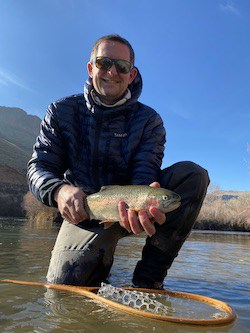
About the Author
My name's Sam and I'm a fly fishing enthusiast just like you. I get out onto the water 80+ times each year, whether it's blazing hot or snow is falling. I enjoy chasing everything from brown trout to snook, and exploring new waters is something I savor. My goal is to discover something new each time I hit the water. Along those lines, I record everything I learn in my fly fishing journal so I can share it with you.
Follow me on Instagram , YouTube, and Facebook to see pictures and videos of my catches and other fishing adventures!
